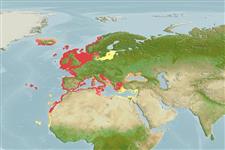Preferred temperature (Acuan
123201): 7.1 - 17.3, mean 10.3 °C (based on 553 cells).
Phylogenetic diversity index (Acuan
82804): PD
50 = 1.0000 [Uniqueness, from 0.5 = low to 2.0 = high].
Bayesian length-weight: a=0.00631 (0.00554 - 0.00719), b=3.08 (3.04 - 3.12), in cm total length, based on LWR estimates for this species (Ref.
93245).
Trophic level (Acuan
69278): 3.1 ±0.1 se; based on diet studies.
Generation time: 3.0 (2.7 - 3.2) years. Estimated as median ln(3)/K based on 58
growth studies.
Daya lenting (Acuan
120179): sedang, Waktu penggandaan populasi minimum 1.4 - 4.4 tahun (K=0.23-0.5; tm=1-2; tmax=15).
Prior r = 0.63, 95% CL = 0.41 - 0.94, Based on 26 full stock assessments.
Fishing Vulnerability (Ref.
59153): Low to moderate vulnerability (30 of 100).
🛈
Climate Vulnerability (Ref.
125649): Low vulnerability (22 of 100).
🛈
Nutrients (Ref.
124155): Calcium = 162 [75, 357] mg/100g; Iron = 2.61 [1.10, 5.76] mg/100g; Protein = 19.8 [18.6, 21.0] %; Omega3 = 1.07 [0.55, 2.10] g/100g; Selenium = 35.9 [18.2, 74.0] μg/100g; VitaminA = 14.5 [4.5, 48.3] μg/100g; Zinc = 1.42 [1.02, 2.25] mg/100g (wet weight); based on
nutrient studies. 